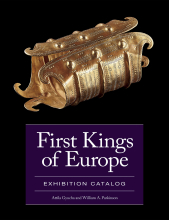Hydria - Catalog No. 102
Record details
Párducz 1965:36, Figure 1; Párducz 1971; Kemenczei 2009:226, Figure 4:1.
Gyucha, Attila and William A. Parkinson, 2023. Hydria - Catalog No. 102 for First Kings of Europe: Exhibition Catalog. Version 1. Cotsen Institute of Archaeology Press. https://doi.org/10.25346/S6/X5XI7F
This large bronze vessel, a so-called ‘hydria,’ was part of the burial assemblage of a chiefly member of the Iron Age society of the Great Hungarian Plain. The assemblage also contained weapons and personal adornments, including a gold diadem, characteristic of the elite of likely Scythian origin of the Middle Iron Age in the region. The vessel was produced in a workshop in Greece, probably in Sparta, and was used as a serving vessel during ceremonies. The object is the most remote known Greek hydria from its place of manufacture, and it likely reached the Great Hungarian Plain through commercial or diplomatic exchanges.
Attila Gyucha
